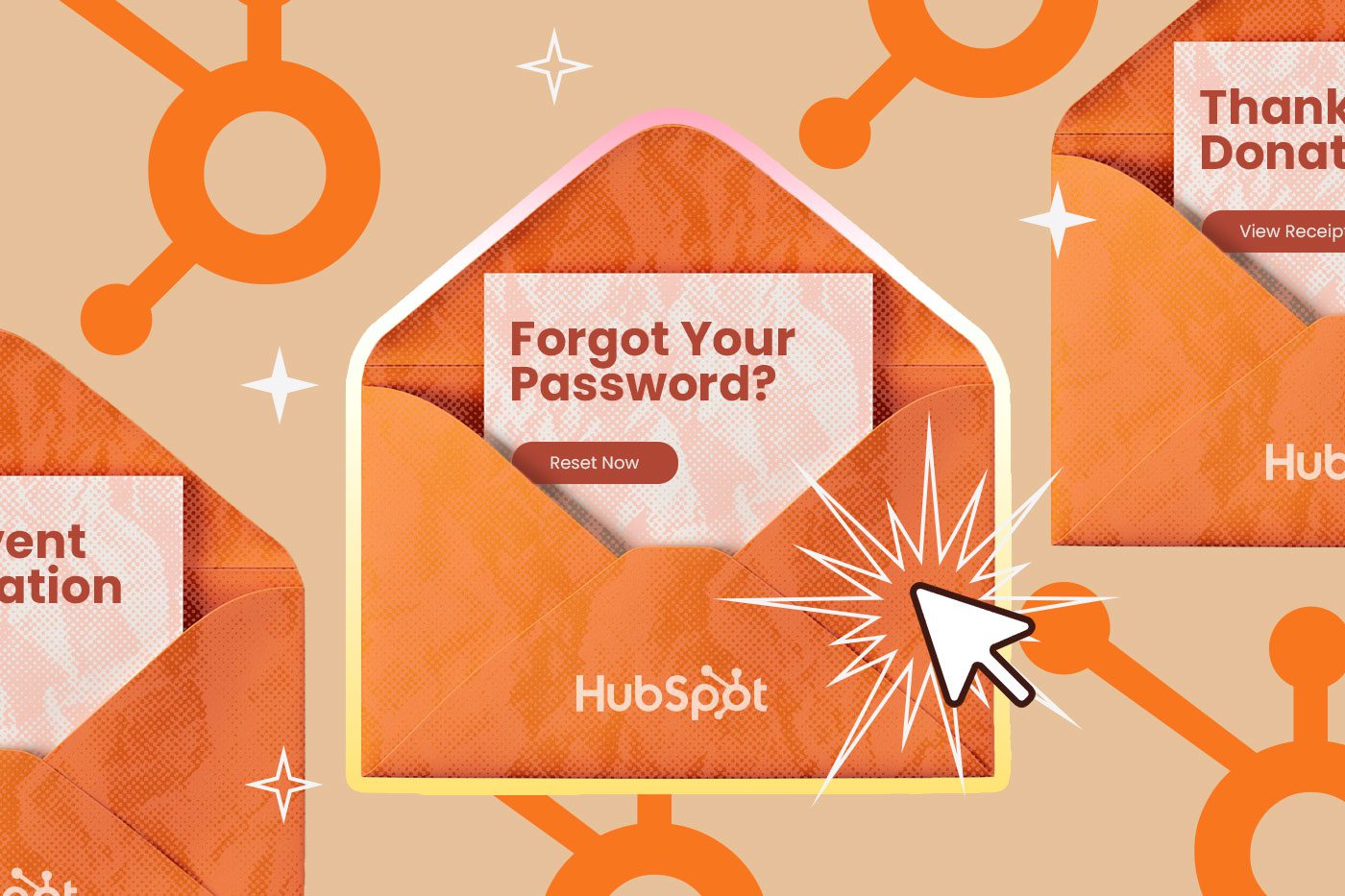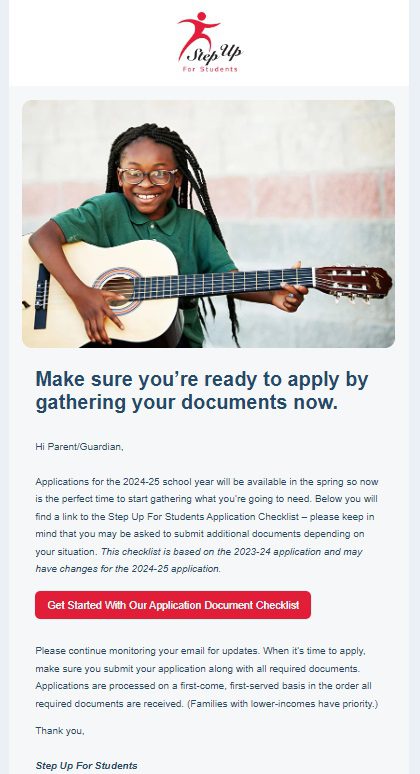Using HubSpot for Transactional Emails for Your Nonprofit
- What are transactional emails?
- When should my nonprofit use transactional emails?
- What triggers HubSpot transactional emails?
- What types of transactional emails can you automate on HubSpot?
- Customer feedback emails
- Purchase and order-related emails
- Account and password management emails
- Customer support and service emails
- Marketing and promotional emails
- How to create and send HubSpot transactional emails
- Tracking the performance of HubSpot transactional emails
- Best practices for using HubSpot transactional emails for your nonprofit
- Benefits of using HubSpot to automate transactional emails
- FAQs about HubSpot transactional emails
- What is another name for a transactional email?
- Do transactional emails need an unsubscribe link?
- How do I prevent HubSpot transactional emails from going to spam?
- Do I need a dedicated IP for HubSpot transactional emails?
- Are there better platforms than HubSpot for sending transactional emails?
- Trust Big Sea to help with your HubSpot marketing needs
Effective email communication is essential for nonprofits. In fact, 26% of donors say email is the communication tool that most inspires them to give.
That’s why you need to master transactional emails (or “trigger emails,” as they’re sometimes called). Unlike marketing emails, transactional emails are automatically triggered by specific user actions and deliver essential information.
Implementing transactional emails should be an integral part of a nonprofit’s marketing and communication strategy. If your organization hasn’t adopted this form of communication, now’s the time to start!
In this article, we’ll explore the significance of transactional emails and guide you on how to use HubSpot to automate and manage them effectively, ensuring that your nonprofit always sends powerful and relevant email communications.

What are transactional emails?
If you think you don’t know what a transactional email is, think again — chances are you have a few in your inbox right now!
Transactional emails are automated messages sent out in response to a very specific action taken by a user. These emails are usually informational and necessary to complete a transaction or to provide updates related to an interaction with your organization.
If you’ve ever purchased something online, or even just reset your email password, you most likely received an immediate automated email response with your receipt or your new password verification. Those types of response emails are examples of transactional emails.
How do transactional emails differ from marketing emails?
While both transactional and marketing emails are a necessary part of email marketing strategies, they have two different purposes. Here they are for comparison:
Transactional emails
Transactional emails are sent in response to a specific user action and contain information the recipient expects to receive. Transactional emails typically have higher open rates because recipients anticipate and find value in the information provided (e.g., a fundraising receipt, confirmation of a form submission, etc.).
Marketing emails
Marketing emails should be designed to promote a product, service, or campaign, and they’re typically sent to a broad audience. These emails are usually informational or promotional, and recipients can unsubscribe or choose not to engage with them.
When should my nonprofit use transactional emails?
Nonprofits often overlook their transactional emails as an opportunity to strengthen their relationship with their donors, but they can absolutely set the tone for your future engagements.
Offering opportunities to engage with your organization at a deeper level, keeping the copy conversational and warm, and of course, tying their transaction to a higher purpose and impact can all serve to help steward them for future gifts.
–Andi Graham, CEO at Big Sea
Transactional emails are vital to your nonprofit’s strategy and should be a key component of your brand experience. These emails are highly effective at delivering essential information triggered by specific user actions.
For instance, if you’re a museum using Hubspot and you want to send immediate receipts to all donors who contributed to your fall charity drive, a transactional email can make this happen.

Using transactional emails this way ensures transparency, builds trust, and provides valuable information that many donors will appreciate for their year-end charitable donation tax records.
Think about the times you’ve made a purchase and didn’t immediately receive a confirmation email: you probably felt uncomfortable or at the very least uncertain that the transaction went through. Trigger emails help build trust that your system works the way it should.
What triggers HubSpot transactional emails?
HubSpot transactional emails are triggered by specific actions taken by users on your website or within your HubSpot-managed platforms. Depending on your campaign goals, your email triggers can vary. However, some of the more common triggers for nonprofits include:
- Completing a donation
- Signing up for an event
- Requesting a password reset
- Submitting a donor feedback form
What types of transactional emails can you automate on HubSpot?
HubSpot can automate various transactional emails, ensuring all essential communications are handled seamlessly. Here’s a breakdown of the types of transactional emails that can be helpful to automate for your nonprofit.
Customer feedback emails
These emails are essential for gathering valuable lead insights from your donors and volunteers, helping to enhance service and engagement. They help build and foster long-term relationships with donors, encourage donor retention, and continually improve service and engagement.
Examples include:
- Survey invitations
- Feedback requests
- Post-event evaluations
- Testimonial submissions
Purchase and order-related emails
These emails are used for a nonprofit that needs to confirm transactions and to keep its supporters and vendors informed about their orders or donations. Examples include:
- Donor notifications
- Delivery confirmations
- Refund confirmations
- Order cancellations
- Auto-donate reminders

Account and password management emails
We’ve all been there — the dreaded forgotten password. In fact, around 78% of people have to reset at least one password every 90 days because they forgot it. With such high numbers, it’s essential to include a password reset or account setup option. This type of transactional email ensures security and privacy for your users. Examples include:
- Password reset emails
- Account verification emails
- Welcome emails
- Account updates
Customer support and service emails
Nonprofits relying on Hubspot for marketing strategies also rely on this platform to manage customer support or any service changes. These automated emails update donors or volunteers regarding support requests or service changes. Examples include:
- Event ticket updates
- Appointment confirmations and reminders
- Terms of service or privacy policy changes
- Password change confirmations
Marketing and promotional emails
While these are “technically” marketing emails, there is a little wiggle room, and they can be triggered by specific transaction-related actions such as:
- Abandoned cart emails
- Product recommendations
- Win-back emails
How to create and send HubSpot transactional emails
Creating and sending transactional emails through HubSpot is essential for your nonprofit’s content marketing strategy. Don’t be discouraged by the five steps below — creating and sending transactional emails is relatively straightforward.
- Set up your HubSpot account – If you still need to implement HubSpot, start there. During setup, ensure your account is a Marketing Hub Professional, Enterprise, or Legacy Marketing Hub Basic account. These accounts are suitable for sending transactional emails. Also, during setup, configure your IP address and verify your domain. A business IP address builds trust and transparency with your donor base.
- Design the email template – Use HubSpot’s email editor to design an email template that aligns with your brand and includes all necessary information. Try to marry your transactional email look with the collateral from your current email marketing strategy, so your branded materials maintain a cohesive message for donors and volunteers.
- Set up automation triggers – Define the actions that will trigger your transactional email, such as a donation or an event registration. To set this up, use HubSpot’s workflow automation and set the triggers on the action of your choice.
- Test the emails – Before launching, test your emails and look for any incorrect rendering. They should be responsive across different devices. Also, look for any misspelled words or incorrect links. This step can help your nonprofit maintain a professional appearance by showing your users that you’re taking the care and time to deliver a polished and reliable communication experience.
- Send and monitor – Once everything is set up, you can go live with your transactional emails. Monitor their performance and make adjustments as needed to improve delivery and engagement rates.
Tracking the performance of HubSpot transactional emails
Track the performance of your transactional emails to understand their effectiveness. Luckily, it’s easy with HubSpot, as the platform provides detailed analytics options that allow you to monitor the following email metrics:
- open rates
- click-through rates
- bounce rates
- list-growth rates
- unsubscribe rates
- overall ROI
Analyzing this data allows you to identify trends, optimize your email content, and improve overall engagement. Review these metrics regularly to ensure your emails are delivered and achieve the desired impact.
Best practices for using HubSpot transactional emails for your nonprofit
Not all emails are created equal, especially when comparing marketing and transactional emails. Transactional emails are a little different from regular nonprofit marketing campaigns, so follow these best practices below so you can maximize the effectiveness of your transactional emails:
- Keep them clear and concise. Transactional emails should be straightforward, providing the necessary information without overwhelming the recipient.
- Ensure brand consistency. Maintain consistent branding across all emails to reinforce your nonprofit’s identity and build trust with your donors and audience.
- Include contact information. Always provide a way for recipients to reach out if they have questions or need assistance.
- Test regularly. Regularly test your emails to ensure they are delivered correctly and are responsive on all devices.
Benefits of using HubSpot to automate transactional emails
Nonprofits often face marketing budget constraints, but HubSpot can be an ideal one-stop (and one-cost) solution for a fully integrated marketing campaign, including email marketing. Using HubSpot for your nonprofit and leveraging its automated transactional email function, you can gain the following benefits:
- A unified communication platform
- Improved tracking and analytics
- Automation and efficiency
- Separation of marketing vs transactions
Marketing trends clearly recommend using emails for nonprofit digital strategy and using HubSpot to automate and send out transactional emails should be a high priority. By leveraging HubSpot’s transactional email feature correctly, your business will strengthen its communication efforts and build lasting relationships with donors!
FAQs about HubSpot transactional emails
What is another name for a transactional email?
Transactional emails are also known as “triggered emails” because they’re sent in response to specific user actions. They’re usually sent to individuals (not to groups) and contain timely — and sometimes confidential — information.
Do transactional emails need an unsubscribe link?
Transactional emails don’t require an unsubscribe link because they aren’t promotional in nature. They’re not selling something; they’re providing the necessary information that the recipient expects to receive.
How do I prevent HubSpot transactional emails from going to spam?
To prevent your transactional emails from being marked as spam, authenticate your domain, use a reputable email service provider, and avoid spammy language or excessive links in your emails.
Do I need a dedicated IP for HubSpot transactional emails?
While you don’t need a dedicated IP, having one can improve your email deliverability. Having a dedicated IP will ensure that your emails are not affected by the reputation of other senders on a shared IP.
Are there better platforms than HubSpot for sending transactional emails?
HubSpot is a powerful platform that effectively manages transactional emails, particularly for nonprofits already using its CRM and other beneficial Hubspot marketing tools. However, there are other platforms on the market that specialize in transactional emails. Deciding to switch to a different platform could be a strategic choice based on your nonprofit’s unique circumstances.
Trust Big Sea to help with your HubSpot marketing needs
Navigating the complexities of transactional emails and HubSpot’s platform can be challenging, but you don’t have to do it alone. Big Sea can support your nonprofit’s marketing and communication efforts, ensuring you maximize HubSpot’s capabilities. Whether you’re just getting started or looking to optimize your current setup, contact us to find out how we can guide you toward success.



